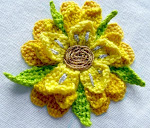So, I tried Corded buttonhole in mid-air aka 3-D, anchored only along the bottom edge and it worked. Just have to work out how best to anchor the straight stitch return so that its unobtrusive. Used a single Trellis stitch to anchor. Let's not forget, front side Trellis is also Rope Stitch and Cup Stitch.
Thoughts on That Bag
If you blow up the view of That Bag to say 200% you can really see the synthesis of texture and form. Its also quite obvious that the stitcher just got really carried away and 'tried this, then tried that'. Everything is just an expression of imagination running away with itself. This is what I really love about that Golden Age of embroidery: its exuberance. I think when you see modern pieces worked faithfully and precisely according to a kind of grid, you lose all the intended exuberance. I believe you have to remind yourself that what you are after is the ultimate expression of FREE FORM embroidery. And free is the key element. All the stitches; all the colours; the metals the whole thing were about celebrating life and God if you ask me. It was actually a very creative expression of spirituality in a way, especially when you remind yourself of the whole socio-political background of the post-Reformation and the revival of that age-old cental motif: The Tree-of-Life. Gone were the icons, the monks, the illuminated manuscripts.
By then the Tree-of-Life idea must have seemed like a celebration of God's bounty in its truest form: the garden.
I just noticed they made a little overlapping thingy using knotted buttonhole. Great, I really like that stitch.
I think I need to do a diagram of how I think they did bits of it and just add to it as I go along. I haven't yet worked out all of it, but I really hope to.
Btw, the spiral trellis you can see at the top starts as the Elizabethan's did it, from the centre outwards. I find this is the prettiest way to do it.














